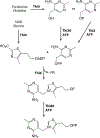The structural and biochemical foundations of thiamin biosynthesis
- PMID: 19348578
- PMCID: PMC6078420
- DOI: 10.1146/annurev.biochem.78.072407.102340
The structural and biochemical foundations of thiamin biosynthesis
Abstract
Thiamin is synthesized by most prokaryotes and by eukaryotes such as yeast and plants. In all cases, the thiazole and pyrimidine moieties are synthesized in separate branches of the pathway and coupled to form thiamin phosphate. A final phosphorylation gives thiamin pyrophosphate, the active form of the cofactor. Over the past decade or so, biochemical and structural studies have elucidated most of the details of the thiamin biosynthetic pathway in bacteria. Formation of the thiazole requires six gene products, and formation of the pyrimidine requires two. In contrast, details of the thiamin biosynthetic pathway in yeast are only just beginning to emerge. Only one gene product is required for the biosynthesis of the thiazole and one for the biosynthesis of the pyrimidine. Thiamin can also be transported into the cell and can be salvaged through several routes. In addition, two thiamin degrading enzymes have been characterized, one of which is linked to a novel salvage pathway.
Figures





















References
-
- Eijkman C 1990. [Anti-neuritis vitamin and beriberi. Nobel Prize paper. 1929]. Ned. Tijdschr. Geneeskd 134:1654–57 - PubMed
-
- Thore S, Leibundgut M, Ban N. 2006. Structure of the eukaryotic thiamine pyrophosphate riboswitch with its regulatory ligand. Science 312:1208–11 - PubMed
-
- Suzuki U, Shamimura T, Odake S. 1912. Oryzanine, a component of rice bran, and its physiological significance. Biochem. Z . 43:89–153
Publication types
MeSH terms
Substances
Grants and funding
LinkOut - more resources
Full Text Sources
Other Literature Sources
Molecular Biology Databases
Miscellaneous

